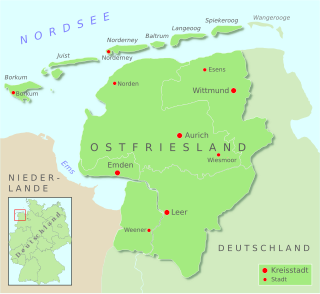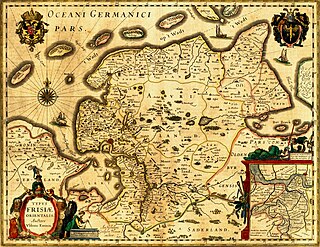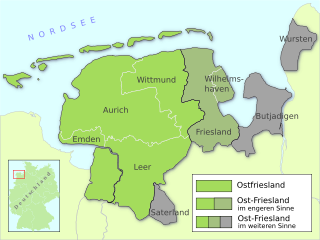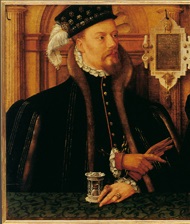
Frisia is a cross-border cultural region in Northwestern Europe. Stretching along the Wadden Sea, it encompasses the north of the Netherlands and parts of northwestern Germany. Wider definitions of "Frisia" may include the island of Rem and the other Danish Wadden Sea Islands. The region is traditionally inhabited by the Frisians, a West Germanic ethnic group.

Wittmund is a Landkreis (district) in the northwestern part of Lower Saxony, Germany. It is situated in East Frisia, on the North Sea coast. Neighboring districts are Friesland, Leer and Aurich.

East Frisia or East Friesland is a historic region in the northwest of Lower Saxony, Germany. It is primarily located on the western half of the East Frisian peninsula, to the east of West Frisia and to the west of Landkreis Friesland.
Hero Oomkens von Esens was a Frisian nobleman, the Lord of Esens, Stedesdorf and Wittmund. He inherited the title upon the death of his father, Sibet Attena von Esens, in 1473.

Enno III of Ostfriesland or Enno III of East Frisia was a Count of Ostfriesland from 1599 to 1625 from the Cirksena family. He was the elder son of Count Edzard II of Ostfriesland and his wife Princess Katarina of Sweden, eldest daughter of King Gustav I of Sweden.

The County of East Frisia was a county in the region of East Frisia in the northwest of the present-day German state of Lower Saxony.

Ulrich I of East Frisia was the first count of East Frisia, from 1408 in Norden to 25 or 26 September 1466, in Emden. He was a son of the chieftain Enno Edzardisna of Norden and Greetsiel, and Gela of Manslagt.

Edzard I, also Edzard the Great was count of East Frisia from 1491 until his death in 1528.

Enno II of East Frisia was the son of Edzard I of East Frisia. In 1528 he became count of East Frisia. For most of his life he ruled together with Johan I of East Frisia, who remained Catholic, while Enno was Lutheran.

Anna of Oldenburg was a Countess consort of East Frisia as the spouse of Count Enno II of East Frisia. She was the Regent of East Frisia in 1542–1561 as the guardian for her minor sons, Johan II and Edzard II. Her reign lasted until 1561 and was generally supported by the Estates.

Rudolf Christian of Ostfriesland, Count of East Frisia, was count of East Frisia, and the second son of Enno III, Count of East Frisia and Anna of Holstein-Gottorp. During his reign, foreign troops participating in the Thirty Years' War began retreating into and quartering in East Frisia. Also during his reign, fen exploitation in East Frisia begins.

The House of Cirksena was the ruling family of East Frisia. They descended from a line of East Frisian chieftains from Greetsiel.
The Battle of Detern on 27 September 1426 marked the prelude to the East Frisian rebellion against the rule of the tom Brok family over East Frisia.

The history of East Frisia developed rather independently from the rest of Germany because the region was relatively isolated for centuries by large stretches of bog to the south, while at the same time its people were oriented towards the sea. Thus in East Frisia in the Middle Ages there was little feudalism, instead a system of fellowship under the so-called Friesian Freedom emerged. It was not until 1464, that the House of Cirksena was enfeoffed with the Imperial County of East Frisia. Nevertheless absolutism had been, and continued to be, unknown in East Frisia. In the two centuries after about 1500, the influence of the Netherlands is discernable - politically, economically and culturally. In 1744, the county lost its independence within the Holy Roman Empire and became part of Prussia. Following the Vienna Congress of 1815, it was transferred to the Kingdom of Hanover, in 1866 it went back to Prussia and, from 1946, it has been part of the German state of Lower Saxony.

East Frisia is a collective term for all traditionally Frisian areas in Lower Saxony, Germany, which are primarily located on a peninsula between the Dollart and the Jade Bight. Along with West Frisia and North Frisia, it is one of the most commonly used subdivisions of Frisia.
The Treaty of Berum was a treaty concluded on 28 January 1600 at Berum Castle, Berum, between the Count Enno III of East Frisia and the County of Rietberg, which regulated the sale of the Lordships of Esens, Stedesdorf and Wittmund to East Frisia.

Berum Castle is located in the Berum district the East Frisian town of Hage in Germany. It is one of the most important sites in East Frisian history.
The Saxon feud was a military conflict in the years 1514–1517 between the East Frisian Count Edzard I, 'West Frisian' rebels, the city of Groningen, and Charles II, Duke of Guelders on the one hand and the Imperial Frisian hereditary governor George, Duke of Saxony – replaced by Charles V of Habsburg in 1515 – and 24 German princes. The war took place predominantly on East Frisian soil and destroyed large parts of the region.

Count John II "the Mad" of Rietberg, called "the Great," was the son of Count Otto III of Rietberg and his second wife, Onna Esens.
Count Otto III Rietberg was Count of Rietberg from 1516 to 1535.













